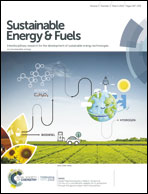Elucidating charge separation in particulate photocatalysts using nearly intrinsic semiconductors with small asymmetric band bending†
Abstract
Photocatalytic water splitting using particulate suspensions is a promising approach for achieving large-scale production of renewable hydrogen fuels. Previous studies have hypothesized that band energy levels of such photocatalysts in water are both flat and symmetrical, and charge separation in such photocatalysts is driven by random charge carrier diffusion. However, it is not well understood how the observed asymmetry of carrier diffusion is achieved during photocatalysis. To fully understand this charge separation process, we used double-side polished, intrinsic silicon as a model light absorber and manipulated the direction of charge-carrier diffusion using combinations of carrier-selective contacts. Degenerately p-type doped and n-type doped silicon, along with the as-grown and annealed TiO2 overlayers grown by atomic layer deposition, was used as carrier selective back and front contacts, respectively. The protective TiO2 layers along with nickel oxide co-catalysts enabled bi-functional, stable silicon photoelectrodes for photoelectrochemical hydrogen evolution and water oxidation in alkaline solution. A device simulation was applied to analyse the experimental results and further gain understanding on the charge separation process in photocatalysts involving semiconductor/liquid junctions. Combined experimental and simulation studies indicated that the contacts established asymmetric band bending inside the intrinsic silicon layer and drove directional charge separation, primarily carrier diffusion. By scaling down the thickness of the silicon layer in the simulation, analogies of charge separation in particulate photocatalysts can be drawn. Based on the findings from intrinsic silicon, we further revealed that photocatalysts generally do require asymmetric band bending to drive diffusional charge separation and that a small band edge offset of 0.45 eV between reductive and oxidative catalytic sites can provide a sufficient, steady-state photovoltage of over 1.23 V for overall water splitting by using a model SrTiO3 absorber. This study provides insightful guidance for designing efficient and stable particulate photocatalysts especially those using Si and III–V semiconductors with protective layers such as TiO2.



 Please wait while we load your content...
Please wait while we load your content...